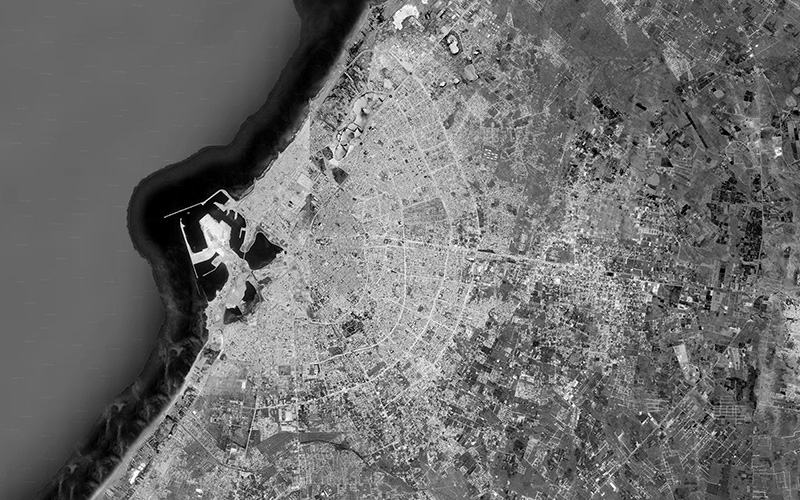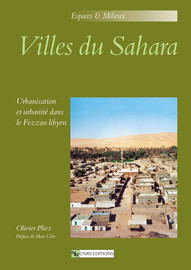Shaba, Faysal. 2019. Urban expansion, land management and development in Tripoli, Libya. Ph.D. dissertation, Sheffield Hallam University, https://www.proquest.com/dissertations-theses/urban-expansion-land-management-development/docview/2548466438/se-2
Libya is considered to have one of the highest rates of urbanisation in the world; especially, when compared to other regions in North Africa and the Mediterranean. Tripoli witnessed rapid population growth and increasing economic development, this led to a concentration of the population in and around the city. Tripoli has witnessed an extreme expansion of its urban area which now contains a population more than 2 million. At the same time, Tripoli is a region which encompasses an area of high agricultural fertility. The objective of this study was to investigate how agricultural land in the Tripoli region could be protected from land use change brought about by rapid urban expansion. This research adopted a mixed methods approach to collect primary and secondary data. Information was gathered from stakeholders, farmers and official sources and triangulated to understand the processes behind rapid urban expansion and the loss of agricultural land. Research included field observations in Tripoli, interviews with government official, and questionnaires for farmers. Research revealed that government policies have played a significant role in creating and exacerbating the problem of urban expansion by encouraging migration to Tripoli. Furthermore, present legislation has been shown to be an ineffective deterrent. Laws are continually broken by various individuals; therefore, current legislation fails to protect agricultural land as it is not enforced properly. This research has, however, identified the existence of effective schemes, such as the National Physical Perspective Plan – Libya(NPPP) and National Spatial Policy (NSP). These schemes would promote balanced sustainable development across Libya, providing better facilities and opportunities in other regions and therefore combat mass migration to larger cities. They have not, however, been implemented due to the difficulty in persuading relevant authorities to do so. This study demonstrates the need for an efficient land use planning in Libya. It provides information to support research and planning efforts related to land development and conservation, ensuring the protection of agricultural land in the face of rapid urban expansion. This is of particular importance to Libya as the percentage of fertile agricultural land is small, around 2% of the country’s total area. The study emphasised the importance of protecting this small but significant land space for future use. The findings of this study will therefore provide a significant guide for future urban planning and will be of use to urban planners and decision makers determining policies and plans to control urban expansion. This study is essential to understanding the changes witnessed in Libya’s agricultural landscape and the need to protect it to ensure its future. Its findings will be used to provide information on effective land management, environmental conservation, and sustainable development, which will be of interest to policy planners and government officials in Libya. Preliminary findings demonstrate that government policies have played a significant role in creating/exacerbating the problem of rural-urban migration to Tripoli. Research has highlighted that national land use policies require revision to achieve future sustainability. Revising policy would enable the country to re-balance the construction of infrastructure and services, accounting for other areas.
Milod, M. 2019. Vernacular architecture in Libya : A case study of vernacular dwellings in the Nafusa mountain region. Ph.D. dissertation, University of Salford, https://www.proquest.com/dissertations-theses/vernacular-architecture-libya-case-study/docview/2344483142/se-2
This research offers a systematic analysis of the physical features of residential Vernacular Architecture (VA) of Nafusa Mountain Region (NMR) in Libya, linking them to the governance system of heritage conservation in Libya and to the Responsible Institutions (RIs). Libya has experienced different historic stages, such as the Amazigh, Phoenicians, Greeks, Romans, Muslims, and Italian colonization. It is distinguished by a historic continuity, which has enriched its historic and architectural features. This study investigates and documents the main physical unique features of residential VA in NMR and related factors that influence Conservation Processes (CPs) within the current governance system delivered by the RIs. By clarifying the elements that make residential VA unique and by understanding current issues undermining its effective conservation, this study offers valuable and original insights for informing future conservation policies and for putting in place measures aimed at restoring, preserving, and maintaining this unique architectural and historical heritage. This research also produces new knowledge about VA of the NMR in Libya, a topic on which no studies have been available so far. By filling the gap in current knowledge, this study raises awareness about the value of the VA in the NMR and contributes to support the conservation of such a unique heritage. The research methodology for this study uses both qualitative and quantitative approaches (Mixed Methods). The researcher has selected and justified three examples of Vernacular Dwellings (VDs) in NMR and collected the data through observation, analysis of dwellings maps, photos, interviews and a questionnaire. Visual survey has been conducted by visiting relevant sites and systematically collecting visual evidence, such as photographic and technical survey including structures and technological spatial details. Spatial analysis methods have been adopted to uncover the rationale of the VA development and construction. Semi-structured interviews with relevant parties have been administered at senior, middle, and junior management level of the RIs and complemented with the review of archival documents and relevant government reports. Findings from the research outline the main challenges to VA in NMR that include a lack of appreciation and understanding of heritage among owners, scarcity of local materials and traditional building skills, lack of government support as well as insufficient documentation. All the findings were triangulated prior to the development of the initial recommendations and further decision-makers and expert validation was obtained to establish the final recommendations. Conclusions and recommendations on how to preserve residential VA in NMR context will assist policy makers in Libya, when setting strategic national plans for VA conservation, and will provide a useful point of reference for academics and researchers.
El Taraboulsi, Sherine Nabil. 2020. State building and state-society relations in Libya (1911-1969): An examination of associations, trade unions and religious actors. Ph.D. dissertation, University of Oxford, https://www.proquest.com/dissertations-theses/state-building-society-relations-libya-1911-1969/docview/2467517897/se-2
This thesis is an examination of state-society relations in Libya during the period preceding the rise of Gaddafi in 1969. It addresses the roots of Libya’s recurring state failure by examining the role played by Libyan social actors in state building during the period between 1911 and 1969. Three key periods in Libya’s history are addressed: the colonial period under the Italians (1911–1943), then the years under the British Military Administration (1943–1951) and then the period as an independent monarchy (1951– 1969). Three social actors are explored: associations or jamʿiyyat, trade unions, and religious groups. Based on Migdal (2004) and Saouli (2012), I approach state formation as a process, not as a finished outcome, and the state as a social field wherein social actors engage with one another as well as with state structures rather than a fixed entity. This approach allows a deeper understanding of the temporal dimensions of Libya’s experience with state building as well as the different processes at play through which states are formed and (un)formed. The thesis makes three key arguments. First, contrary to the majority of Western scholarship on Libya which ascribes Libya’s “statelessness” to a failure to adopt modern state formation following independence, I argue that this linear view oversimplifies a much more complex local power dynamic among social actors, and between social actors and the state (colonial and postcolonial) that manifested itself in modes of cooperation and contestation that shaped Libya’s experience with state building. This view of “statelessness” also suggests that divisions in Libya’s social fabric are endemic which is not the case. Through a social history of the period in question, the thesis shows that while contestation among social actors before and after independence had been stronger than centralizing forces, this should be explained in context and in history. Second, I argue that 8 within non-Western societies where a normative notion of the modern nation-state was imposed but was adopted by local actors and adapted to social, cultural and historical realities that are local, it is within the civic space that society was empowered to shape the state in both constructive and (de)constructive ways, and that there is a pattern to how this shaping happens that is embedded within the history of those societies. Third, the thesis demonstrates that Libya’s civic space has played a twofold role in state formation. On the one hand, it has actively contributed to the strengthening of resistance forces against colonialism, the development of state institutions and the domestication of state power as experienced in the Kingdom of Libya (1951 – 1969). On the other hand, because of societal differences, many of which resulted from aggressive colonialism, a short history of institutionalization and the entrenchment of fragmentation and regional differences, Libya’s civic space manifested processes of localism or bonding and coalescing that occurred within groups which compromised the development of a Libyan state as in the case of the Tripolitanian Republic (1918 – 1922). The thesis demonstrates that state building can be compromised by contested state-society relations and that a state in the making would need to incorporate various forms of its civic space within its bureaucracies and overall model of government to ensure its local legitimacy and geopolitical unity. Using a sociohistorical approach which includes primary data from archives in London, Rome and Tunis, as well as 80 semi-structured interviews, this research makes a contribution to a social history of twentieth-century Libya by exploring its civic space and its engagement with governing structures, colonial and independent.
Khalifa, Asmaa. 2022. Everyday leadership in self-organized groups: Rising to occasions of leadership in Libya. Ph.D. dissertation, Arizona State University, https://www.proquest.com/dissertations-theses/everyday-leadership-self-organized-groups-rising/docview/2671565211/se-2
The simplicity of everyday living creates opportunities for leadership based on individually curated personal networks that have developed overtime through the act of living and personal experience. These networks are unique to individuals; however, when grouped, they share enough similarities with others in their proximal environment, thus, allowing for the formation of spontaneous self-organized groups, based on either a felt need, a shared history, a common goal, or combination of such. These leadership opportunities heed the call for action within their community because the felt need is proximal. This exploratory ethnographic case study investigates the nature of leadership within self-organized groups and how it differs from other forms of collective action. Participant interviews and observations were used to explore how individuals interpreted their roles in the group along with how they assessed and fulfilled a felt need within their community, and the different meanings of leadership in self-organized groups.



